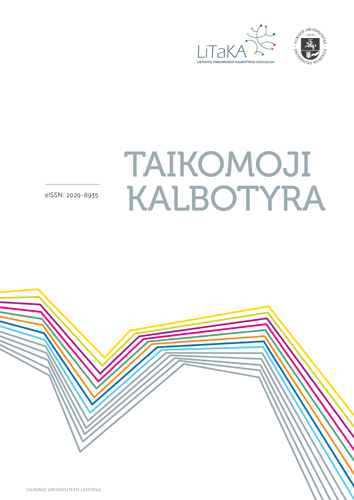Kalbėjimas su tėvais tarmiškai ir gyventojų požiūris į tarmes Žemaitijos miestuose (kiekybinė analizė)
Talking dialect to parents and the attitude towards dialects in Žemaitija towns (quantitative analysis)
Author(s): Regina KliukienėSubject(s): Sociolinguistics
Published by: Vilniaus Universiteto Leidykla
Keywords: dialect; usage; language attitudes; quantitative analysis; sociolinguistics;
Summary/Abstract: Currently more and more research is devoted to the analysis of the linguistic situation of Lithuanian towns and villages (cf. Ramonienė et al. 2010). The issues of the choice of linguistic varieties and analysis of the trends of using dialects in private and public life as well as relationship between dialectal speech and standard language deserve special attention (Ramonienė et al. 2010; Ramonienė 2006; Aliūkaitė 2007; 2011; Kalėdienė 2009). This paper makes use of the material and the quantitative data from the project The sociolinguistic map of Lithuania: towns and villages implemented by Vilnius University, the Lithuanian Language Institute and Vytautas Magnus University in 2010-2012 as well as of the maps drawn by Viktorija Baranauskienė on the basis of the same data (2013). A more detailed analysis of dialects used by children in communication with their parents in the towns of Žemaitija region (cf. the map The use of dialects in communication with parents among the respondents and regional distribution of dialects) is given and the features of a dialect used in Klaipėda, the largest town of Žemaitija, and smaller towns as well as the opinions of the residents of Žemaitija about the most usual, most valuable and most intelligible dialect and promotion of the use of dialects among young people are discussed separately. The quantitative data is presented in graphs and maps. According to the quantitative data, the use of heterogeneous, or ‘mixed’, and homogenous, or ‘pure’, dialects of the towns of Žemaitija region in communication with parents is as follows: the Žemaitian dialect prevails in many ‘pure’ towns of Žemaitija such as Plungė, Rietavas, Telšiai, Gargždai, Šilalė, Skuodas. The residents of these towns are also more favourably disposed towards the Žemaitian dialect—the majority would encourage young people to learn and speak the dialect; however, a smaller percentage think that the Žemaitian dialect is the most beautiful. In the ‘mixed’ towns of Žemaitija region (where both the Aukštaitian dialect and the Žemaitian dialect are used) Šiauliai, Kuršėnai and Šilutė only 1–5 per cent use the Žemaitian dialect in communication with parents, but there the Žemaitian dialect is considered the most usual and the most beautiful.
Journal: Taikomoji kalbotyra
- Issue Year: 2014
- Issue No: 5
- Page Range: 1-15
- Page Count: 15
- Language: Lithuanian

